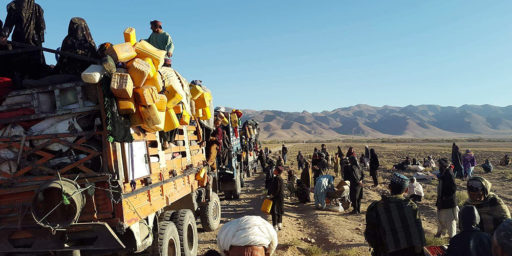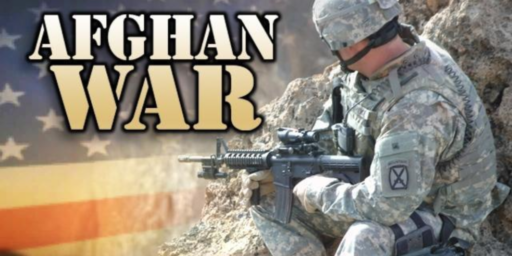The Clinton Mind-Set
Peter Feaver, a highly regarded defense scholar at Duke, makes an interesting argument in a WaPo op-ed today.
The commissioners on the Sept. 11 panel asked the same question over and over: Why didn’t the Clinton administration take stronger military action against al Qaeda’s Taliban refuge in the 1990s, when the Sept. 11 plot was being hatched?
Former secretary of state Madeleine Albright’s consistent response was simple: “You have to go back to the pre-9/11 mindset.” By this she meant that before Sept. 11, stronger military action was politically impossible; thus the blame for the Clinton administration’s failures to act preemptively against al Qaeda rests on everyone, not specifically on the commander in chief.
Defenders of the Clinton administration have twinned this claim — “We can’t be blamed, because no one wanted us to take stronger military action” — with its post-9/11 obverse assertion: President Bush doesn’t deserve any credit for toppling the Taliban and ending al Qaeda’s sanctuary, because after Sept. 11 anyone would have done this. In the words of Bush’s most recent and surprising critic, former counterterrorism czar Richard Clarke: “Any leader whom one can imagine as president on September 11 would have declared a ‘war on terrorism’ and would have ended the Afghan sanctuary by invading.”
But the first claim is only partly true, and because it is, the second claim is almost certainly false.
Albright is partly correct; there was a pre-9/11 mindset that shaped Clinton-era responses. The mind-set was “counterterrorism as law-enforcement.” The role of the military was at best a supporting one. Moreover, because the uniformed military themselves opposed a military role, the law enforcement mind-set was reinforced by Clinton’s pathological civil-military relations. Even if President Clinton wanted to conduct military operations against al Qaeda, he was simply too weak a commander in chief to prevail over a military that wanted nothing to do with a war in Afghanistan.
The Clinton record on military operations was clear: frequent resort to low-risk cruise-missile strikes and high-level bombings, but shunning any form of decisive operations involving ground troops in areas of high risk. The Clinton White House was the most casualty phobic administration in modern times, and this fear of body bags was not lost on Osama bin Laden. Indeed, al Qaeda rhetoric regularly “proved” that the Americans were vulnerable to terrorism by invoking the hasty cut-and-run after 18 Army soldiers died in the 1993 “Black Hawk Down” events in Somalia — a strategy developed and implemented, ironically enough, by the same Richard Clarke who torments the Bush team today.
Indeed, one could call the “Clinton Mind-Set” the “European Mind-Set.”
The risky approach ordered by Bush and Secretary of Defense Donald Rumsfeld, which relied heavily on Special Forces and air power, was especially subject to criticism. As late as Nov. 4, 2001, the dean of academic security studies experts, John Mearsheimer, was warning in an opinion piece that “neither the current bombing campaign nor the deployment of American ground forces to Afghanistan offers good military options for dealing with the Taliban and al Qaeda. A better approach would emphasize ground-level diplomacy, with open wallets, among Pashtun leaders in central and southern Afghanistan.” Viewed in hindsight, the Bush-Rumsfeld military plan looked brilliant, but at the time it was highly controversial and decidedly risky.
Would a less stubborn commander in chief have pursued the risky war plan that ultimately toppled the Taliban and put al Qaeda on the run? The record of the ’90s suggests otherwise. A White House that cut and ran after the death of 18 soldiers probably would not have had the stomach for the possible casualties. A White House that could not prevail over military objections to using ground troops in Kosovo would have had a hard time overcoming institutional military objections. A White House that ordered retaliation in the form of a night-time strike on an empty intelligence building would not have backed Operation Enduring Freedom.
I’m less sure of that. Indeed, a large part of the risk averseness of Clinton foreign policy–and of hightailing it out of Somalia after the Blackhawk Down incident–was that it was unwilling to incur sinking public opinion polls as a cost of war. Going to war against the Taliban was hugely popular in the wake of 9/11; I can’t imagine a Clinton Administration passing that up. Now, Feaver may be right that they’d have pursued a less risky military strategy. Perhaps they’d have used a longer air campaign instead of the SF-intensive ground action. Then again, Hugh Shelton and Tommy Franks were on board and would have been in charge of planning. The main difference–and it may have been decisive–is a different SecDef and ASD.





and the Kerry mindset